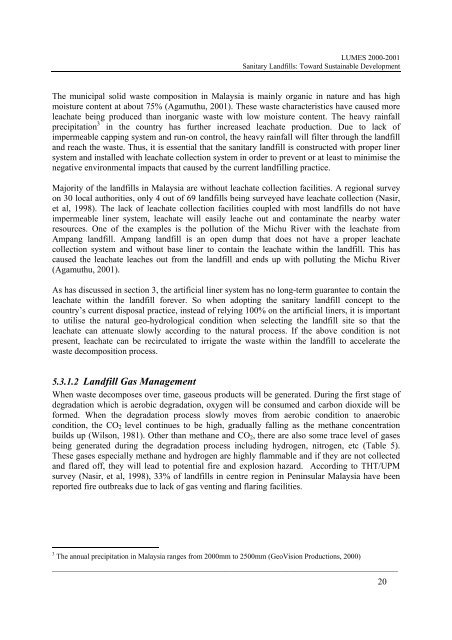Sanitary Landfills: Toward Sustainable Development - lumes
Sanitary Landfills: Toward Sustainable Development - lumes
Sanitary Landfills: Toward Sustainable Development - lumes
You also want an ePaper? Increase the reach of your titles
YUMPU automatically turns print PDFs into web optimized ePapers that Google loves.
LUMES 2000-2001<br />
<strong>Sanitary</strong> <strong>Landfills</strong>: <strong>Toward</strong> <strong>Sustainable</strong> <strong>Development</strong><br />
The municipal solid waste composition in Malaysia is mainly organic in nature and has high<br />
moisture content at about 75% (Agamuthu, 2001). These waste characteristics have caused more<br />
leachate being produced than inorganic waste with low moisture content. The heavy rainfall<br />
precipitation 3 in the country has further increased leachate production. Due to lack of<br />
impermeable capping system and run-on control, the heavy rainfall will filter through the landfill<br />
and reach the waste. Thus, it is essential that the sanitary landfill is constructed with proper liner<br />
system and installed with leachate collection system in order to prevent or at least to minimise the<br />
negative environmental impacts that caused by the current landfilling practice.<br />
Majority of the landfills in Malaysia are without leachate collection facilities. A regional survey<br />
on 30 local authorities, only 4 out of 69 landfills being surveyed have leachate collection (Nasir,<br />
et al, 1998). The lack of leachate collection facilities coupled with most landfills do not have<br />
impermeable liner system, leachate will easily leache out and contaminate the nearby water<br />
resources. One of the examples is the pollution of the Michu River with the leachate from<br />
Ampang landfill. Ampang landfill is an open dump that does not have a proper leachate<br />
collection system and without base liner to contain the leachate within the landfill. This has<br />
caused the leachate leaches out from the landfill and ends up with polluting the Michu River<br />
(Agamuthu, 2001).<br />
As has discussed in section 3, the artificial liner system has no long-term guarantee to contain the<br />
leachate within the landfill forever. So when adopting the sanitary landfill concept to the<br />
country’s current disposal practice, instead of relying 100% on the artificial liners, it is important<br />
to utilise the natural geo-hydrological condition when selecting the landfill site so that the<br />
leachate can attenuate slowly according to the natural process. If the above condition is not<br />
present, leachate can be recirculated to irrigate the waste within the landfill to accelerate the<br />
waste decomposition process.<br />
5.3.1.2 Landfill Gas Management<br />
When waste decomposes over time, gaseous products will be generated. During the first stage of<br />
degradation which is aerobic degradation, oxygen will be consumed and carbon dioxide will be<br />
formed. When the degradation process slowly moves from aerobic condition to anaerobic<br />
condition, the CO2 level continues to be high, gradually falling as the methane concentration<br />
builds up (Wilson, 1981). Other than methane and CO2, there are also some trace level of gases<br />
being generated during the degradation process including hydrogen, nitrogen, etc (Table 5).<br />
These gases especially methane and hydrogen are highly flammable and if they are not collected<br />
and flared off, they will lead to potential fire and explosion hazard. According to THT/UPM<br />
survey (Nasir, et al, 1998), 33% of landfills in centre region in Peninsular Malaysia have been<br />
reported fire outbreaks due to lack of gas venting and flaring facilities.<br />
3<br />
The annual precipitation in Malaysia ranges from 2000mm to 2500mm (GeoVision Productions, 2000)<br />
______________________________________________________________________________<br />
20

















